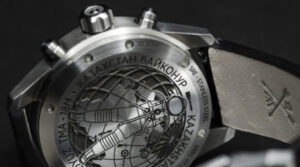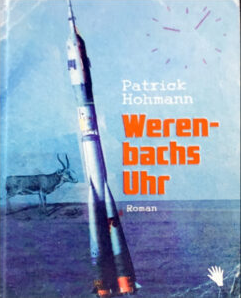Relógio NFC
O material do foguete Neosid cria um significado especial com RFID Relógio NFC. O trabalho tem sido árduo, e a equipe do projeto desenvolveu componentes RFID miniaturizados. Incluindo etiquetas que podem ser usadas em ambientes metálicos. Seus produtos podem ser usados para gerenciamento de equipamentos e ferramentas cirúrgicas. Essas etiquetas são compatíveis com pequenos itens de metal. Estes produtos são fabricados com ferrite. Um material cerâmico composto de ferro (Iii) óxido e outros elementos metálicos. De acordo com Yilmaz Benzer, diretor de vendas e marketing da Neosid, o desafio para Werenbach era criar conectividade no relógio sem alterar a estética.
Após três anos de desenvolvimento
O Mach 33 watch foi lançada há dois anos e inclui Funcionalidade NFC. Matthias Höß, Neosid’s R&D Manager, disse: "Nossa tarefa era desenvolver um transponder NFC muito fino. Para o estilo de mostrador do relógio, para que todos os proprietários de relógios possam entrar em contato com a Estação Espacial Internacional (ISS).” Muitos clientes estão muito entusiasmados com isso,” disse Homan, que primeiro concebeu a ideia em 2010.
Dois anos mais tarde, Homan viajou pelo Cazaquistão até o ponto em que os motores de foguete Soyuz geralmente retornam à Terra após os lançamentos de Samara, Rússia. Homan reuniu material da turbina de aço do foguete ou do invólucro de alumínio. Esses materiais são então fundidos para fazer parte do mostrador. Ele escreveu um romance sobre esse conceito chamado Werenbachs Uhr (Relógio de Werenbach). Para compradores de Mach 33, Isso significa que eles têm o direito de se gabar de que seu relógio está em órbita. Mas nosso objetivo é fornecer essa história para que eles e seus amigos possam acessá-la olhando para o coração do lançamento. Que é a Estação Espacial Internacional.

Relógio NFC
Neosid começou a trabalhar
A Neosid começou a trabalhar com Werenbach na conectividade NFC há cinco anos. Para ambas as empresas, Os desafios técnicos do sistema são bastante assustadores. Incrustações padrão não são possíveis devido ao ambiente metálico, tamanho pequeno e exigências estéticas. Willenbach fez algumas modificações no relógio, fazendo o plástico do estilo do mostrador. E a pequena placa de metal no mostrador é uma peça que visitou o espaço. "É um ambiente crítico,” Benzer disse. "O relógio antigo era feito de metal.”
Teste
A Neosid testou uma variedade de transponders que podiam ser muito pequenos e planos. "Então, combinado com o design de um relógio com uma forma especial, temos a solução certa,” lembra Benzer. Höß explicou que o transponder está na parte de trás do mostrador. Portanto, permanece invisível

Relógio NFC 2
Sible, embora envie um sinal quando interrogado através da face do mostrador de plástico. Ele acrescentou que a antena é circular para fornecer melhores características elétricas do que outros projetos. E o embutimento utiliza um escudo de ferrite para que funcione apesar da caixa do relógio.
Patrick Homan
Para Mach 33 relógios, o alcance de leitura NFC é normalmente de cerca de 5 cm (2 polegadas). "É uma distância de leitura muito confortável,” diz Höß, "Espaço suficiente sem contato direto com o relógio.” Isso também protege o mostrador, como nenhuma batida física é necessária. A Neosid atribui o longo alcance de leitura ao uso de núcleos de ferrite.
Quando o usuário coloca o telefone dentro do alcance do relógio, o interrogador NFC integrado do telefone captura o número de identificação exclusivo da etiqueta e abre um URL. Através do qual o proprietário do relógio pode acessar a visualização ao vivo através da janela da estação espacial. Neosid usa chips ICODE da NXP Semiconductors, bem como chips microeletrônicos EM. As dimensões do IC no núcleo de ferrite são 1,4 mm x 1,2 mm x 0,5 mm (0.06″ x 0,05″ x 0,02″).
Yilmaz Benzer
Desde que o relógio foi lançado, os clientes usaram o recurso NFC para visualizar o conteúdo da Estação Espacial Internacional. Bem como acessar dados sobre outros produtos. As empresas relatam que os planos para a próxima geração do relógio estão em andamento, que pode incluir o uso de peças adicionais de foguetes. "Nosso maior desafio foram os materiais que usamos — alumínio e aço ” Homan disse. Ele prevê que essas novas versões do relógio podem ser mais desafiadoras para a NFC.
Mathias Hawes
"Decidimos nos concentrar no movimento mecânico.” Homan disse, "E use apenas mostradores feitos inteiramente de alumínio de foguete espacial real.” Isso significa que o NFC pode não funcionar em tal ambiente, ele observou. Acrescentando que : "Não há uma maneira fácil de separar o embutimento NFC do mostrador sem quebrar seu design.” Portanto, a empresa ainda está determinando se a funcionalidade NFC será implementada no próximo projeto. "Certamente, Esperamos que a microtecnologia possa resolver esse desafio em breve. Isso seria interessante, com certeza.”
UHF RFID TAG
A Neosid fornece tecnologia para rastrear ferramentas cirúrgicas via RFID HF ou UHF. E seus transponders também estão sendo desenvolvidos para implantação na indústria odontológica. Os transponders NeoTAG da empresa são usados atualmente para monitorar a manutenção de equipamentos. Como bombeiros e ativos de segurança. Isso inclui equipamentos de elevação e eslingas. Bem como componentes para construção de túneis e pontes, fundição, Construção naval e aeroespacial.





